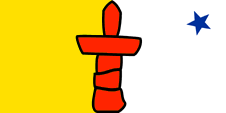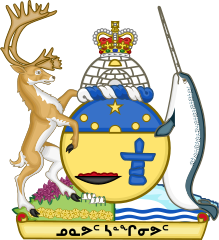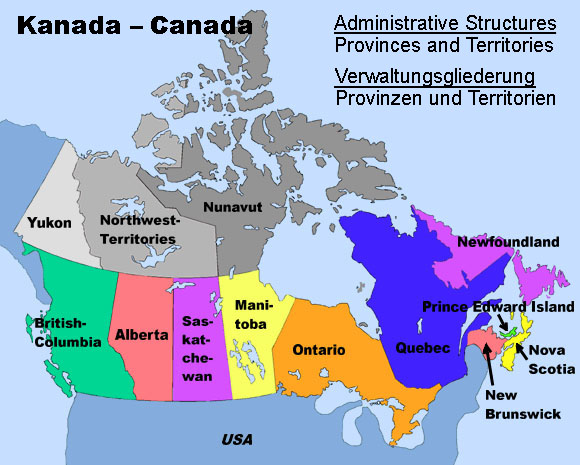Nunavut |
|
|
|
| Übersicht – Contents: | |
Flagge – Flag: |
|
 |
Flagge des Nunavut-Territoriums – flag of the Nunavut Territory, Seitenverhältnis – ratio = 1:2, Quelle/Source: Wikipedia (D)   |
Bedeutung/Ursprung der Flagge – Meaning/Origin of the Flag: |
|
| Die Flagge von Nunavut wurde am 01.04.1999 erstmals gehisst. Sie ist vertikal in Gelb (Gold) und Weiß (Silber) geteilt. Gelb steht für den Reichtum an Bodenschätzen und Weiß für Eis und Schnee. In der Mitte zwischen beiden Farben ein roter "inukshuk", eine Steinsäule die eine Person darstellt, und von den Inuit als Wegweiser oder auch als Meilenstein verwendet wird. In der rechten Oberecke des weißen Feldes befindet sich ein blauer fünfzackiger Stern, der Nordstern. Die fünf Zacken stehen für die fünf idigenen nordischen Völker der Eskimo: Inuit (Kanada), Inuvialuit (Kanada), Kalaallit (Grönland), Inupiaq (Alaska) und Jupikyt (Russland). | The flag
of Nunavut was hoisted first on 1st of April in 1999. It is vertically
divided in yellow (gold) and white (silver). Yellow stands for the mineral wealth and white for ice and snow. In the middle between both colours a red "inukshuk", a stone pillar representing a person and used by the Inuit as directional marker or milestone. In the right upper corner of the white field is a blue five-pointed star, the North Star. The five jags stand for the five indigenous nordic peoples of the Eskimo: Inuit (Canada), Inuvialuit (Canada), Kalaallit (Greenland), Inupiaq (Alaska) und Jupikyt (Russia). |
| Quelle/Source: Wikipedia (D) | |
Wappen – Coat of Arms: |
|
 |
Wappen von Nunavut – coat of arms of Nunavut, Quelle/Source: Di (they-them), based on blazon provided by the Canadian Heraldic Authority, CC BY-SA 4.0, via Wikimedia Commons |
Bedeutung/Ursprung des Wappens – Meaning/Origin of the Coat of Arms: |
|
| Das Wappen des kanadischen Nunavut-Territoriums wurde anlässlich der Gründung des Territoriums von Generalgouverneur Roméo LeBlanc genehmigt. Es ist gewiss das erste Wappen in der Welt, das Symbole der Inuit in ein herkömmliches Wappen einbindet. Das Schild ist kreisrund und ist horizontal blau und gelb zweigeteilt. Die etwas kleinere obere Hälfte ist blau und zeigt den Nordstern, die größere untere Hälfte ist golden und steht für den Reichtum des Landes an Mineralien oder auch für die Mitternachtssonne, und sie enthält die Abbildungen eines "qulliq", einer Steinlampe, welche für die Wärme der Häuser und der Gemeinschaft steht, und eines "inukshuk", einer Steinsäule die eine Person darstellt, und von den Inuit als Wegweiser oder auch als Meilenstein verwendet wird. Die Wappenkrone zeigt ein Iglu. Es steht für das traditionelle Leben, das Weiterbestehen und die Regierung von Nunavut. Auf dem Iglu die britische Krone. Sie steht für die königliche Macht. Schildhalter sind ein Karibu (Rentier) und ein Narwal. Sie repräsentieren den Lebensunterhalt und die natürlichen Ressourcen des Landes zu Wasser und an Land. Sie stehen auf einem Postament, rechts mit arktischem Mohn, Zwergfeuerkraut und arktischer Heide bewachsen, und links einen Eisberg im Wasser zeigend. Auf der Vorderseite des Postamentes in Inuktitut, einer der Sprachen der Inuit das Landesmotto "Nunavut Sanginivut" → "Nunavut unsere Kraft" | The coat
of arms of the Canadian Nunavut Territory was approved on the occasion of
the foundation of the Territory by Governor General Roméo LeBlanc. It is certainly the first coat of arms in the world, which shows symbols of the Inuit inside an conventional coat of arms. The shield is round and horizontally twofold divided in blue and yellow. The some smaller upper half is blue and shows the North Star, the biger below half is golden and stands for the mineral wealth of the country or also for the midnight sun, and it containes the depictions of a "qulliq", a stone lamp which stands for the warmth in the houses and the community, and an "inukshuk", a stone pillar representing a person and used by the Inuit as directional marker or milestone. The crest shows an igloo. It stands for the traditional live, the survival and the government of Nunavut. On the igloo the British crown. It stands for the royal sovereignty. Shield holders are a caribou (reindeer) and a narwhal. They represent the livelihood and the natural resources of the country of the land and sea. They stand on a compartment which on the right is overgrown with Arctic poppies, dwarf fireweed, and Arctic heather, and to the left it shows an iceberg at sea. On the front of the compartment in Inuktitut, one of the der languages of the Inuit the motto of the country "Nunavut Sanginivut" → "Nunavut our strength" |
| Quelle/Source: Wikipedia (D) | |
Landkarte – Map: |
 |
| Landkarte/Map: Volker Preuß |
Zahlen und Fakten – Numbers and Facts: |
|
|
|
|
|
|
|
|
|
|
|
|
|
|
|
|
|
|
Geschichte: |
| ca.
10.000–4.000 Jahre v.Chr. · Besiedlung durch Vorfahren der Eskimos ca. 1000 · Normannen erreichen die kanadische Ostküste 1576 · Martin Frobisher, ein englischer Seefahrer, entdeckt die Küste von Baffin Island 17. Jahrhundert · Expeditionen unter Henry Hudson, William Baffin und Robert Bylot 1670 · englische Pelzhändler gründen die Hudson's Bay Company (HBC), die HBC kolonisiert in der Folgezeit ganz Kanada zwischen Neufrankreich den Rocky Mountains, Labrador und dem Nordrand der Hudson-Bucht 1869 · die Hudson's Bay Company (HBC) überträgt alle ihre territorialen und Hoheitsrechte an das britische Dominion Kanada 1870 · Bildung der Nordwest-Territorien aus den Gebieten der HBC, Rupertsland und Nordwestliches Territorium, die Arktischen Inseln kommen unter direkte britische Verwaltung 1870 · Bildung der Provinz Manitoba durch Herauslösung aus den Nordwest-Territorien 1876 · Bildung des Keewatin-Territoriums durch Herauslösung aus den Nordwest-Territorien 1880 · Eingliederung der Arktischen Inseln in die Nordwest-Territorien 1881 · Vergrößerung der Provinz Manitoba durch Angliederung von Gebieten des Keewatin-Territoriums 1883 · Bildung der Territorien Alberta, Athabaska, Saskatchewan und Assiniboia durch Herauslösung aus den Nordwest-Territorien 1895 · Bildung des Franklin-Distrikts und des Mackenzie-Distrikts innerhalb der Nordwest-Territorien, und des Yukon-Territoriums im äußersten Nordwesten durch Herauslösung aus den Nordwest-Territorien 1905 · Eingliederung von Keewatin als Distrikt in die Nordwest-Territorien 1912 · nochmalige Vergrößerung der Provinz Manitoba durch Angliederung der südlichen Gebiete des Keewatin-Distrikts 1925 · Ausdehnung der Grenzen der Nordwest-Territorien als Sektorengrenzen bis hin zum Nordpol 01.04.1999 · Bildung des Eskimo Nunavut-Territoriums mit einer eigenen Regionalregierung durch Ausgliederung aus den Nordwest-Territorien auf Kosten des Keewatin-Distrikts, fast des gesamten Franklin-Distrikts und großer Teile des Mackenzie-Distrikts |
History: |
| ca.
10.000–4.000 years B.C. · settlement by ancestors of the Eskimos ca. 1000 A.D. · Normans reach the Canadian eastern coast 1576 · Martin Frobisher, an English seafarer, discovers the coast of Baffin Island 17th century · expeditions under Henry Hudson, William Baffin and Robert Bylot 1670 · English furriers establish the Hudson's Bay Company (HBC), the HBC colonizes in the afteryears whole Canada between New France, the Rocky Mountains, Labrador and the northern rand of the Hudson Bay 1869 · the Hudson's Bay Company (HBC) cedes all their territorial rights and prerogatives to the British Dominion of Canada 1870 · formation of the Northwest Territories from the former properties of the HBC, Rupertsland and Northwestern Territories, the Arctic Islands come under direct British administration 1870 · establishment of the Province of Manitoba by dividing off the Northwest Territories 1876 · establishment of the Keewatin Territory by dividing of the Northwest Territories 1880 · incorporation of the Arctic Islands into the Northwest Territories 1881 · enlargement of the Province of Manitoba by annexation of territories of the Keewatin Territory 1883 · establishment of the Territories Alberta, Athabaska, Saskatchewan and Assiniboia by dividing off the Northwest Territories 1895 · establishment of the District of Franklin and the District of Mackenzie within the Northwest Territories, establishment of the Yukon Territory in the outer northwest by dividing off the Northwest Territories 1905 · incorporation of Keewatin as district in the Northwest Territories 1912 · once again enlargement of the Province of Manitoba by annexation of the southern regions of the District of Keewatin 1925 · extension of the borders of the Northwest Territory as sector's frontiers towards the North Pole 1st of April 1999 · establishment of the Eskimo Nunavut Territory with an own regional government by dividing off the Northwest Territories at the cost of the District of Keewatin, of nearly the whole District of Franklin and of large parts of the District of Mackenzie |
| Quelle/Source: Atlas zur Geschichte, World Statesmen, Wikipedia (D), Discovery '97 |
Ursprung des Landesnamens – Origin of the Country's Name: |
|
| Der Name des Territoriums stamm aus der Sprache der Eskimo (Innuit) und heißt übersetzt "unser Land". | The name of the territory goes back to the language of the Eskimo (Innuit) and means translated "our country". |
| Quelle/Source: Wikipedia (D) | |